
7 minute read
trAVeL Island Resort & Casino Cashes In On Post- COvID Golf Boom
Considering his confidence to wisely gamble on a $33-million renovation when a pandemic was digging in more than a golfer trying to blast out of a bunker while standing in ankle sock-deep sand, Tony Mancilla has a hot hand.
Anyone who has walked into his Island Resort & Casino in Michigan’s Upper Peninsula surely can appreciate the swagger.
Advertisement
So this year, Mancilla, general manager of the 12-floor resort, which is located just west of Escanaba, plans to go to the tribal counsel and play his hand. He says he’s going to request to build.
Again.
The Island Resort & Casino is wholly owned and operated by the Hannahville Indian Community, which is a federally recognized Potawatomi Indian Tribe. The Island Resort & Casino is part of the Gambling & Gaming industry.
“There are two ways to manage demand,” Mancilla said. “You either increase the price and lower the demand or you increase the supply.”
Mancilla envisions more golf holes. That’s the demand of those who visit this destination, which is one of the Midwest’s largest for golf. The Island Resort & Casino boasts two of Michigan’s best golf courses in Sweetgrass, which is celebrating its 15th year in 2023, and nearby Sage Run, which opened in 2018. Both 18-hole courses were designed by acclaimed golf course architect Paul Albanese.
“I don’t know if they’re going to do it or not,” Mancilla said of the Island Resort & Casino counsel. “But that’s our direction. We grow with the demand. As we grow, people seem to fill in the rooms and take the tee times.”
A casino-operation only in 1985, the Island Resort & Casino moved three miles down the road to its current location in 1991. (You can’t miss the water tower, which extends like Victor Wembanyama on a playground court.)
“They just had cards at that time, blackjack in a bar,” Mancilla said of the original casino, which now serves as Hannahville’s community center. “It was so popular that we needed more space for parking and whatnot.”
Thirty-two years ago, the Island Resort & Casino opened as a 28-room motel. It expanded to 113 rooms six years later and to 326 rooms in 2007. As of January 2022, the resort boasts 454 rooms with enough entertainment and eating options that patrons, whether young or old, never have to step foot off the property to enjoy a worthwhile stay. The property includes the two golf courses—Sage Run is a 10-minute drive away—three restaurants on its main floor, and a high-end restaurant on the 12th floor with a view of Sweetgrass, a spa, a small water park, and theater-style showroom.
“Here’s a little tidbit for you,” said Mancilla, who’s been at the casino for nine years after serving as a lawyer for the Hannahville Community for 17 years. “Our year-round occupancy with 454 (rooms) is higher than it was when we had 113 rooms. It’s because of the golf courses and our amenities as we’ve added on.”
The Island’s showroom features 1,315 seats and has hosted some of the biggest names in entertainment. It was nominated as one of the five finalists for the 46th Academy of Country Music Awards in the Industry Award category of Casino of the Year in 2011. The remainder of the 2023 entertainment includes rocker Ted Nugent (Sept. 22-23), psychic medium Matt Fraser (Oct. 6-7), pop-rock trio Hanson (Nov. 3-4) and, just in time for Christmas, the Oak Ridge Boys (Dec. 8-9).
Just three years ago, however, entertainment world-wide came to a screeching halt. COVID-19 was rampant. The Island Resort & Casino had a decision to make regarding a planned $33 million renovation.
It was March 2020.
“We were deciding whether we were going to break ground and get it done,” Mancilla said. “We said, this (pandemic) isn’t going to last forever. We had pre-purchased all of our materials, stored them and brought in all of the labor. People were looking to work, so there wasn’t an increase in labor at that time.”
So the Island Resort & Casino played its hand.
It was a winning hand.
“If we would have waited a year, the price would have gone up 40%,” Mancilla said. “We lucked out. We got it done.”
The expansion was completed in 2022 —coming in $1.5 million under budget, Mancilla said—and included the upscale Horizons Steakhouse, Splash Island and 128 new guest rooms and suites. Last year saw the additions of The Reef and Reef Pizza and the dedicated sportsbook area open on the gaming floor. A new top-of-theline outdoor sign was installed.
When the sportsbook opened in September 2022, it became the first sports betting venue open in Upper Michigan and Wisconsin.
Mancilla says his facility is the second-oldest Indian casino in the country.
“There were bingo halls before that in Oklahoma and California, but bingo is different from a casino,” said Mancilla, whose father is Mexican and whose mother is from the Hannahville tribe. A native of Idaho, he took the bar exam in his home state and attended the University of New Mexico for law school.
Casinos are classified as Class III games (roulette, craps, blackjack, slot machines), “everything you can do in Las Vegas and Atlantic City,” as Mancilla put it.
Mancilla shared a history lesson, explaining how in the U.P. a chairman from one of the tribes put a casino in his garage. The federal courts closed him down but said while an individual couldn’t have a casino, a tribe could.
“All of a sudden, a light went on,” Mancilla said.
Bay Mills, a waterfront resort in Brimley, Michigan, and just a couple of hours away from the Island Resort & Casino, put up the first casino with cards. The Island Resort & Casino followed shortly afterward.
“So, really, the Indian casino concept began in the U.P. in Michigan,” Mancilla said.
The Native American theme is consistent at the Island Resort & Casino. Sweetgrass, which sits adjacent to the resort, was named the 2021 National Golf Course of the Year by the National Golf Course Owners Association and is home to the EPSON Tour’s Island Resort Championship. Sweetgrass refers to an aromatic herb and sacred plant used in Native American peace and healing rituals. The grass is planted throughout the course.
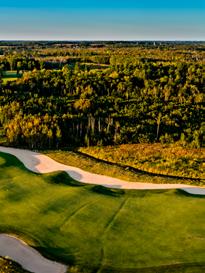
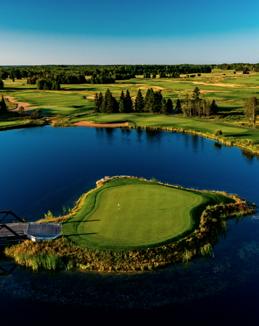
The prairie links-style course meanders to a wide-open vista where many greens and flags can be seen in the distance. The course also features historic wood and iron bridges repurposed from other parts of the state.

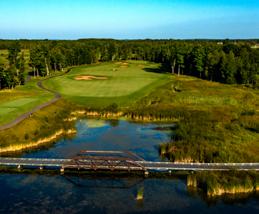
Throughout the course, golfers encounter the rich history of the Hannahville Community, with holes named after traditional Potawatomi clans, villages, allies, medicine, and symbols.
“It’s my own philosophy and the Native American philosophy that we always try to make the design fit the land, and truly allow it to reflect the principles of Native Americans’ respect for the land,” said Albanese, a Harvard University transplant who lives in Plymouth, Michigan.
“This also inspired stories to share throughout the course. We put some wooden posts in the side of a hill along the fairway that represent the remains of a fort from the 1650s. And the green complex itself worked out very nicely to be a redan-style green. Redan is the French word for fortress.”
On June 10, 2018, Sage Run opened 10 years to the day after Sweetgrass debuted. With clear skies, visibility is 20 miles from elevated views of the course. The relative newbie is rustic in style and bunker heavy.
If the Island Resort & Casino gets the greenlight from its counsel to build more golf holes, Mancilla said it probably would be done at Sage Run.
“We have a lot of property,” Mancilla said. “We’re thinking of starting with nine holes and designing them after the Golden Age of the ‘20s. As the land fits, we’ll find holes that fit that.”
The goal remains to give visitors, golfers in this case, what they want.
“Everyone wants those 7:30 to 10 (a.m.) tee times,” Mancilla said. “If you added nine (holes), you could send people off the front of Sage Run and they could play the back, and you could send people off the back of Sage Run and they could play the new nine. So instead of having two sets of prime tee times like we do now at Sweetgrass and Sage Run, we’d have three sets. You’re adding another 36 golfers being able to go off in the early morning, because that’s what (customers) want to do here. They want to go have their round of golf and they either go re-play it if they’re avid golfers or they come inside.”
If the chips fall the way Mancilla hopes, construction could start next summer.
“It’s exciting,” Mancilla said. “But nothing is definitive.”
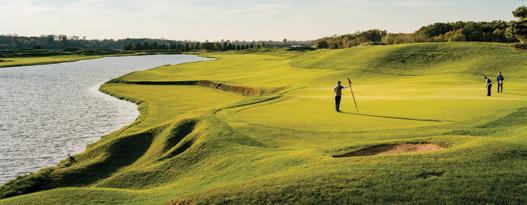
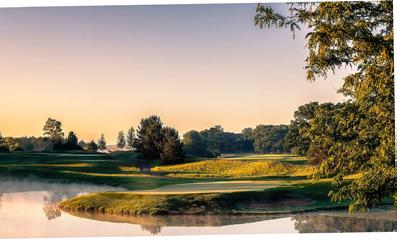
Stand on the first tee of Flossmoor Golf Club on Chicago’s south side and you immediately find yourself going back into the origins of the game. In front and around you rest 187 rolling acres of perfectly manicured fairways featuring landing areas tightened by sprawling, irregularly-edged bunkers. If you feel as though you are playing golf in the early 1900s, it is because you are walking in the same footprints as Bobby Jones, Chick Evans, and Frances Ouimet.
All of them took on this Herbert J. Tweetie-designed course not many years after the course opened in 1899. Then, and throughout its 124-year history, Flossmoor has stood the test of time as one of the Midwest’s showcase parkland golf courses.
Home to the 1920 PGA Championship and the 1923 U.S. Amateur Championship, Flossmoor G.C. will host the 74th Illinois Open Championship July 31 – August 2. The state’s premier players, including defending champion David Perkins, will be tested by Flossmoor’s lurking hazards and trademark U.S. Open-fast putting surfaces.
“The course has always been known for its greens,” said Flossmoor Director of Golf George Goich. “While the course offers plenty of challenges from the tees to the fairways, the real test occurs when calculating where to hit the ball on these greens and then how to read the putts when you get on the green.”
The distinctive character of each hole is recognized by its nickname. The 488-yard No. 1 is called “Road” due to its similarities to the famous “Road Hole” No. 17 on the Old Course at St. Andrews in Scotland. The 422-yard No. 6 is called
“Neuk” which is Scottish for an angular piece of land. The rolling No. 11 is called “Spion Kop” and references a steep hill in South Africa. The 420-yard No. 3 is called “Home” as it was the 18th hole on the course’s original configuration.
In 2009, Flossmoor received a major renovation performed by acclaimed Michigan architect Ray Hearn. The massive project included restoring and modernizing the then-110-year old property. Greens and bunkers that had grown smaller over the years were expanded. Trees that had tightened holes were taken out to allow for strategies to be implemented as original designer Tweetie had intended. The end-result was nationally heralded as “Course Renovation of the Year” by Golf magazine
“I consider our work at Flossmoor to be one of my proudest achievements,” said Hearn in an interview. “The course was designed during golf’s ‘golden age’ so we wanted to recapture the essence of what Tweetie wanted it to be. While trees







